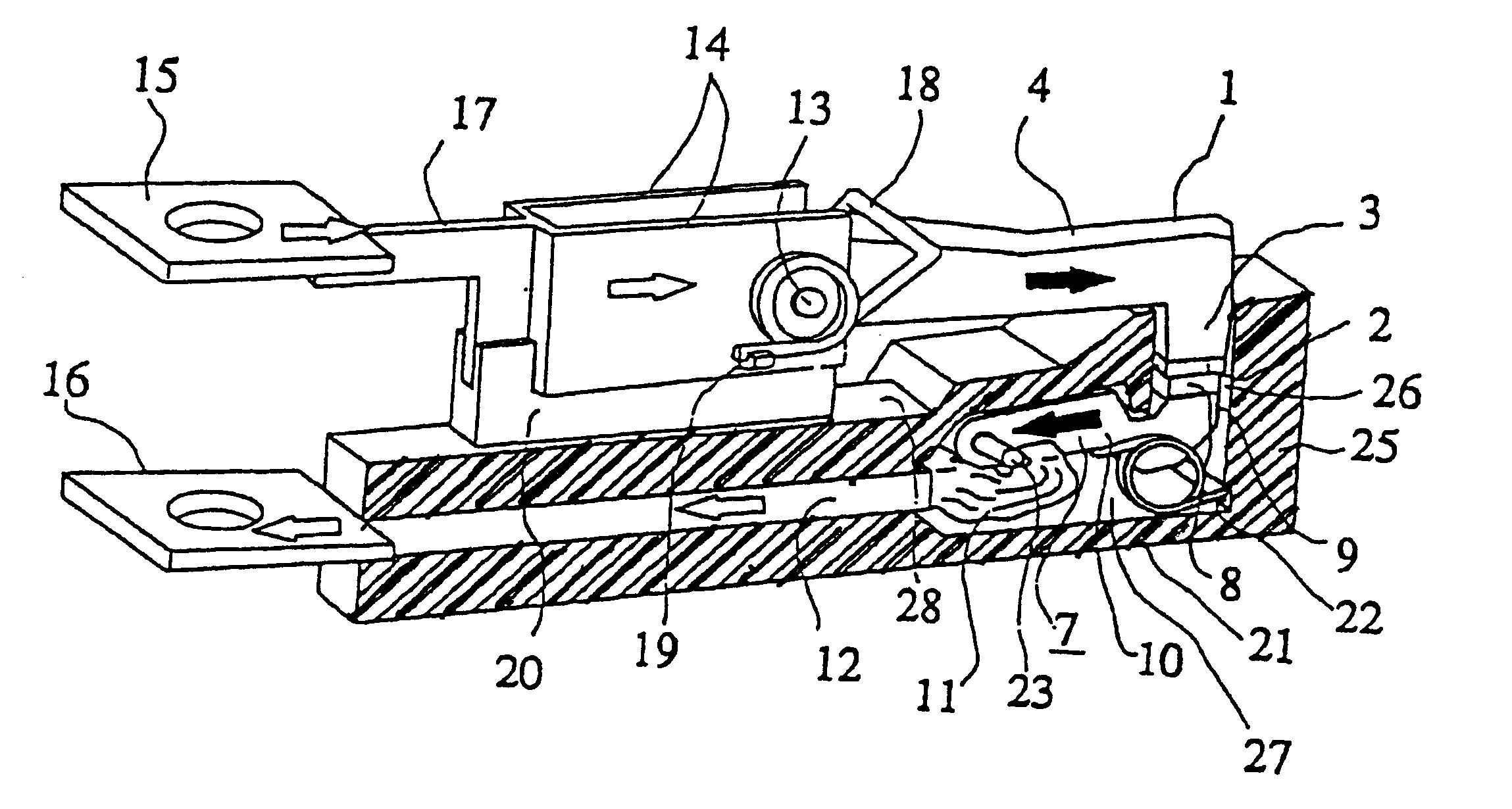Current limiting device and circuit interrupter having a current limiting function
a current limiting device and circuit interrupter technology, applied in circuit-breaking switches, circuit-breaking switches for excess currents, protective switch details, etc., can solve the problems of high possibility of insulation breakdown at the wall surface, difficult for the current limiting element portion, and complex structur
- Summary
- Abstract
- Description
- Claims
- Application Information
AI Technical Summary
Benefits of technology
Problems solved by technology
Method used
Image
Examples
embodiment 1
The first embodiment of the present invention will now be described in conjunction with FIG. 1. FIG. 1 is a perspective view showing the main portion of a circuit interrupter according to the first embodiment in the contact closed state, with one portion of a cylindrical insulator 25 and an insulating cover 28 which is an electrical insulator covering the stationary conductor 12 is removed for illustrating the internal structure. In FIG. 1, 1 is a movable member of substantially L-shape having a movable contact 2 and a movable arm vertical portion 3 to which the movable contact 2 is secured and a movable arm horizontal portion 4 substantially perpendicular to the movable arm vertical portion 3. The movable member 1 forms one contact pair together with a repulsive member 7 composed of a repulsive contact 8 and a repulsive arm vertical portion 9 and a repulsive arm horizontal portion 10, the movable member 1 and the repulsive member 7 are biased in the contacting direction to each oth...
embodiment 2
The second embodiment of the present invention will now be described in conjunction with the figure. FIG. 9 is a fragmental sectional view showing the main portion such as the cylindrical insulating material 25, the repulsive member 7, the movable member 1 and the like of this embodiment, and in the figure, a locus drawn during the contact separating movement by the point of the movable member 1 most remote from its rotating center is depicted by a dot-and-dash line, and a locus drawn during the contact separating movement by the point of the repulsive member 7 most remote from its rotating center is depicted by a dash line. The surface portions of the cylindrical insulating material 25 that oppose to the tip portions of the movable member 1 and the repulsive member 7 are configured into an arc-shape to maintain a constant clearance with respect to the dot-and-dash line and the broken line. Generally, the rotary shaft 13 of the movable member 1 is disposed above the contact contacti...
embodiment 3
The third embodiment of the present invention will now be described in conjunction with the figure. FIG. 10 is a fragmental sectional view illustrating the main portion such as the cylindrical insulating material 25, the repulsive member 7, the movable member 1 and the like of this embodiment, the cylindrical insulating material 25 being composed of an insulating material 25a defining a cylindrical inner surface and a surrounding insulating material 25b around the material 25a. The insulating material 25a is a mold made of a material that emits a large amount of vapor immediately when exposed to the arc, such as a resin material including only a small amount of or no reinforcing material such as glass fibers, and the insulating material 25b is made of an reinforced resin or a ceramic superior in mechanical strength. With this structure, a material that cannot mechanically endure the elevated pressure within the cylinder can be used as a material for defining the cylinder inner surfa...
PUM
 Login to View More
Login to View More Abstract
Description
Claims
Application Information
 Login to View More
Login to View More - R&D
- Intellectual Property
- Life Sciences
- Materials
- Tech Scout
- Unparalleled Data Quality
- Higher Quality Content
- 60% Fewer Hallucinations
Browse by: Latest US Patents, China's latest patents, Technical Efficacy Thesaurus, Application Domain, Technology Topic, Popular Technical Reports.
© 2025 PatSnap. All rights reserved.Legal|Privacy policy|Modern Slavery Act Transparency Statement|Sitemap|About US| Contact US: help@patsnap.com



